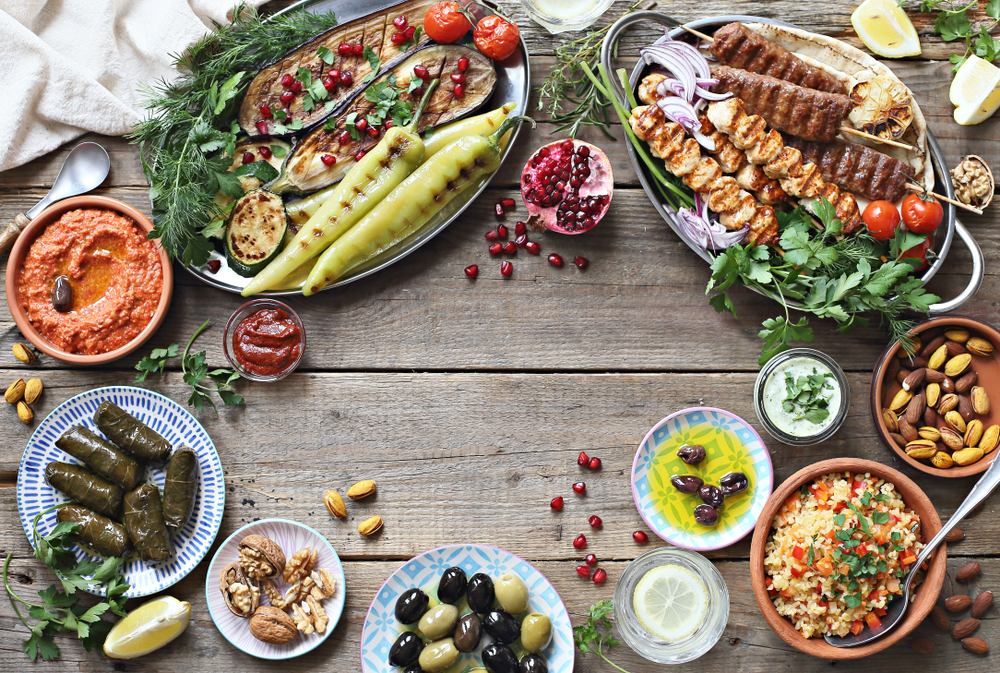
The Real Mediterranean Diet
From your email, please click on the title to view the photos and comment online. On the Website, you can read past blogs, search for recipes, and browse.
What about a completely different approach to meals, one that makes them not only more healthful, but also more relaxed, convivial, and social? I’m talking about creating an enjoyable meal that evokes comfort and happiness. Visualize a food tradition that has a great dietary mix of proteins and roughage with a variety of fresh and seasonal meats, grains, nuts, and fruits. You’ll find it with one of the oldest cuisines in the world – the Mediterranean.
Cooking with the senses
What also appeals to me is that the cooking is instinctive. In writing about this region, food ambassador, chef, and cookbook author Bethany Kehdy noted in The Jewelled Kitchen that recipes are usually passed down over the centuries, most often from mother to daughter. However, she says, precise weights and measures are rare: a large spoonful of this, a coffee cup of that, a squeeze of lemon. To ensure that the food meets the host’s standards, Kehdy recommends not only using high-quality ingredients, but also to rely on your senses: taste the dish as you cook. After all, tomatoes can vary in quality and flavor, and the acidity of lemons can fluctuate. “You can’t taste too much.” The approach reminds me of my grandmother’s cooking style, which was revered in our farm community in Illinois.
The Mediterranean cuisine Kehdy describes is not the foods we associate with Greece and Italy, but rather those from the other side of the Mediterranean. Having grown up in Lebanon, Kehdy, who now lives in the U.S., describes a dinner party as a contradiction to the typical three-course American fare. Instead, the food is a balance of flavors, textures, and temperatures, all designed to make the guests comfortable, happy, and sated. Even before being seated at a table, guests are greeted with tea and a selection of dried fruits, nuts, and pastries. That’s just to whet their appetite.
Entertaining with joy
The relaxed meal that follows could be at a formal table or even upon a cloth spread on the floor. Before the guests are a variety of dishes, served in quick procession. And breads – typically flatbreads – play a major role, even substituting for cutlery to scoop up food. Kehdy advises guests at such a meal to proceed slowly, eating less on a first helping. That’s because the host will be urging second and third helpings to experience the pleasure and pride of taking care of guests and witnessing their enjoyment.
As for the food, Kehdy says that Persian, Iraqi, and Gulf cuisines share similarities while showing traces of Mediterranean influences. They’re more abundant in meat, with a host of rice dishes. The spices are from India, likely because of the early connection with the 4,000-year-old spice trade, which began in the Middle East. On the other hand, the cuisines of Turkey, Lebanon, Syria, Palestine, Jordan, and North Africa, she says, use large amounts of legumes, grains, nuts, citrus, garlic, fresh herbs, and allspice.
Crafting the menu
What specifically would you make for such a meal? In a 2019 New York Times article, chef and author Samin Nosrat relates her favorite recipes from her Persian background: plates both sweet and sour, soft and crunchy, raw, hot, and cold. You’ll experience rice as the cornerstone of the meal, and enjoy the tahdig, the crispy rice crust against which every Persian cook is measured. The cuisine treats herbs almost as vegetables rather than just a garnish, with a basket of fresh herbs, radishes, and scallions to be eaten raw or tucked into flatbread with a bite of feta, cucumber, or walnuts. The rest of the feast could feature a frittata, a stew or two, and a salad. You’ll also likely find yogurt, possibly with cucumbers or other additional ingredients. And don’t expect a dessert, which is not part of the tradition. Kehdy says that meals might also interweave nuts and fruits or something like a lime and rosewater granita.
After all, the goal is to have happy guests. Cooking, Kehdy says, is meant to be fun, so run with your senses and enjoy yourself. Her uncle always told her: “Eat and you shall forget your worries.” Such a sentiment is worth a try, don’t you think?
From your email, you can log in to Farmboy in the Kitchen and comment at the end of the blog to share your thoughts or suggest a topic.
If you’d like to share the blog, click on the Facebook icon or one of the others. Thanks!





3 Comments
Carol Birkland
Lynn, my experience with the Med diet was when Tom and I were volunteers on an Israeli kibbutz in the late 70’s . Breakfast was salad and I loved it with olives some white cheese that looked somewhat like cottage that I would spread on bread and top with cucumber slices and salt. We ate the same thing for the last meal of the day in the communal dining hall. Lunch was main meal and it was terrible. The kibbutz “cooks” reduced all vegetables to a grey mush and nobody cared since good was viewed as only the fuel that you needed in able to work. But the salads were great.
Jean C
Thanks for sharing a lovely and smart way to approach our meals, Lynn.
“Run with your senses and enjoy yourself.”
Tracy May
I love Mediterranean food. Never heard of tahdig though. Reminds me of nurungji (scorched rice), my favorite Korean food!